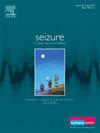Biallelic SCN1A variants with divergent epilepsy phenotypes
IF 2.7
3区 医学
Q2 CLINICAL NEUROLOGY
引用次数: 0
Abstract
Purpose
Pathogenic SCN1A variants most commonly cause autosomal dominant Dravet syndrome and genetic epilepsy with febrile seizures plus (GEFS+). However, rare homozygous SCN1A variants have also been reported. We report two new cases of homozygous SCN1A variants associated with divergent epilepsy phenotypes.
Methods
We retrospectively reviewed the charts of two unrelated patients with different homozygous SCN1A variants. We also reviewed all published cases of biallelic SCN1A pathogenic variants, focusing on the epilepsy phenotypes.
Results
Patient 1 had a homozygous c. 1676T>A, (p. Ile559Asn) variant of uncertain significance, inherited from asymptomatic parents. Patient 1 exhibited early afebrile seizures controlled by first-line anti-seizure medications and no febrile seizures or status epilepticus, as well as profound developmental delay, macrocephaly, and mild dysmorphic features. Patient 2 had a homozygous pathogenic c. 4970G>A, (p. Arg1657His) variant carried by asymptomatic parents. This patient presented with early, recurrent, and prolonged febrile seizures, moderate developmental delay, and motor dysfunction and was diagnosed with Dravet syndrome. We identified 16 further cases from the literature. Including our cases, 9/18 (50 %) were diagnosed with Dravet syndrome and 6/18 (33 %) with GEFS+. The mean age of seizure onset was 7 months (range 3–19 months). Phenotypes ranged from intact neurodevelopment with controlled epilepsy to profound developmental delay and refractory epilepsy.
Conclusion
These cases highlight and expand the phenotypic spectrum associated with biallelic SCN1A variants. While some patients present typically for Dravet/GEFS+, others may present with developmental delay in the absence of febrile seizures or status epilepticus. Further studies are needed to confirm genotype-phenotype relationships.
具有不同癫痫表型的双等位SCN1A变异
目的致病性SCN1A变异最常引起常染色体显性Dravet综合征和遗传性癫痫伴热性癫痫发作(GEFS+)。然而,罕见的纯合子SCN1A变异也有报道。我们报告了两个新的纯合子SCN1A变异与发散癫痫表型相关的病例。方法回顾性分析两例不同纯合子SCN1A变异的无亲缘关系患者的图表。我们还回顾了所有已发表的双等位基因SCN1A致病变异病例,重点关注癫痫表型。结果患者1具有一个意义不确定的纯合c. 1676T> a (p. Ile559Asn)变异,遗传自无症状父母。患者1表现为早期发热性癫痫发作,由一线抗癫痫药物控制,无发热性癫痫发作或癫痫持续状态,同时出现深度发育迟缓、大头畸形和轻度畸形特征。患者2为无症状父母携带的纯合子致病性c. 4970G> a (p. Arg1657His)变异。该患者表现为早期、复发性和延长的发热性惊厥、中度发育迟缓和运动功能障碍,并被诊断为Dravet综合征。我们从文献中确定了另外16例病例。包括我们的病例,9/18(50%)被诊断为Dravet综合征,6/18(33%)被诊断为GEFS+。癫痫发作的平均年龄为7个月(范围3-19个月)。表型范围从完整的神经发育与控制癫痫到深度发育迟缓和难治性癫痫。结论这些病例突出并扩展了与双等位基因SCN1A变异相关的表型谱。虽然一些患者的典型表现为Dravet/GEFS+,但其他患者可能在没有发热性癫痫发作或癫痫持续状态的情况下表现为发育迟缓。需要进一步的研究来证实基因型-表型的关系。
本文章由计算机程序翻译,如有差异,请以英文原文为准。
求助全文
约1分钟内获得全文
求助全文
来源期刊

Seizure-European Journal of Epilepsy
医学-临床神经学
CiteScore
5.60
自引率
6.70%
发文量
231
审稿时长
34 days
期刊介绍:
Seizure - European Journal of Epilepsy is an international journal owned by Epilepsy Action (the largest member led epilepsy organisation in the UK). It provides a forum for papers on all topics related to epilepsy and seizure disorders.
 求助内容:
求助内容: 应助结果提醒方式:
应助结果提醒方式:


